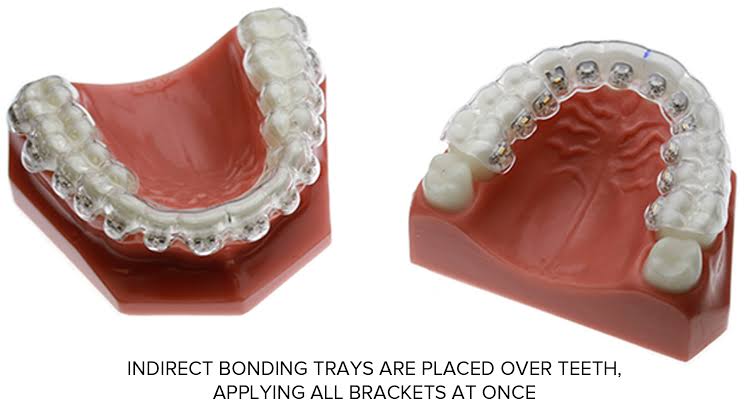Modern orthodontics offers improved precision and comfort, with bonding techniques playing a key role in attaching brackets to teeth. The two main methods, direct and indirect bonding, each have their pros and cons. This guide explores both approaches to help orthodontic professionals choose the best option for their practices.
Understanding Direct Bonding
Direct bonding is the traditional and more conventional method for placing orthodontic brackets. As the name suggests, this technique involves applying each bracket directly onto the tooth surface one at a time, right in the dental chair.
The Direct Bonding Procedure
The process is meticulous and requires significant chair-side time and precision from the orthodontist. The typical steps include:
- Tooth Preparation: The teeth are first polished and then etched to create a microscopic texture on the enamel. This roughened surface helps the adhesive form a strong mechanical bond.
- Applying Adhesive: A bonding agent is applied to the prepared tooth surface.
- Bracket Placement: The orthodontist carefully places a composite adhesive on the back of a bracket. Using specialized tweezers, they position the bracket onto the center of the tooth.
- Positioning and Curing: The orthodontist adjusts the bracket to its ideal position for optimal tooth movement. Once satisfied, they use a curing light to harden the adhesive, permanently fixing the bracket in place.
- Repeat: This process is repeated for every tooth that requires a bracket.
Advantages of Direct Bonding
- Simplicity: The technique is straightforward and doesn’t require extensive lab work or preparation before the patient’s appointment.
- Lower Initial Cost: Since there are no lab fees associated with creating custom trays, the initial overhead cost for direct bonding is lower.
- Flexibility: Orthodontists can make real-time adjustments to bracket placement as they work, accommodating for unusual tooth shapes or positions on the spot.
Disadvantages of Direct Bonding
- Time-Consuming: Placing each bracket individually is a lengthy process, which can lead to longer appointment times and patient fatigue.
- Technique-Sensitive: The accuracy of bracket placement is highly dependent on the orthodontist’s skill and experience. Minor errors can lead to longer treatment times and additional adjustments down the line.
- Patient Discomfort: Keeping the mouth open for an extended period can be uncomfortable for patients, especially younger ones. The presence of saliva and moisture can also compromise the bond’s strength if not managed carefully.
Exploring Indirect Bonding
Indirect bonding is a more modern approach that involves placing the brackets on a dental model of the patient’s teeth first and then transferring them to the actual teeth using a custom-made tray.
The Indirect Bonding Procedure
This method shifts much of the detailed work from the chair-side to the laboratory, resulting in a more streamlined clinical process.
- Creating a Model: An accurate impression or digital scan of the patient’s teeth is taken to create a physical or virtual model.
- Lab-Based Bracket Placement: In the lab, a technician or the orthodontist places the brackets onto the model with high precision. This controlled environment allows for ideal positioning without the clinical challenges of moisture or patient movement.
- Fabricating the Transfer Tray: Once the brackets are perfectly positioned on the model, a custom tray is fabricated over them. This tray, typically made of a flexible silicone-like material, holds the brackets securely in their predetermined positions.
- Chair-Side Application: During the patient’s appointment, the teeth are prepared similarly to the direct bonding method (etching and priming). The adhesive is then applied either to the teeth or to the backs of the brackets in the tray.
- Transfer and Curing: The tray, with all the brackets embedded, is fitted over the patient’s teeth. Gentle pressure is applied to ensure full seating. The adhesive is then cured, and the tray is carefully removed, leaving all the brackets perfectly bonded to the teeth.
Advantages of Indirect Bonding
- Enhanced Accuracy: Bracket placement is generally more precise because it is done in a controlled lab setting, free from clinical variables. This accuracy can lead to more predictable tooth movement and potentially shorter treatment times.
- Reduced Chair Time: The actual bonding appointment is significantly shorter and more efficient, as all brackets are placed simultaneously. This improves the patient experience and allows the clinic to see more patients.
- Improved Patient Comfort: Shorter appointment times and a less tedious procedure contribute to a much more comfortable experience for the patient.
- Stronger Bonds: The lab environment allows for better control over adhesive application, which can result in stronger, more reliable bonded brackets.
Disadvantages of Indirect Bonding
- Higher Initial Cost: The process involves lab fees and materials for creating the model and transfer trays, increasing the initial cost.
- Requires Lab Work: The technique relies on a well-equipped lab and skilled technicians. Any inaccuracies in the initial impression or model can lead to poorly fitting trays and compromised bracket placement.
- Less Flexibility: Spontaneous adjustments are not possible during the bonding appointment. If a bracket is misplaced, a new tray or a direct bonding fix may be necessary.
A Comparative Analysis
When choosing between direct and indirect bonding, orthodontists must weigh the trade-offs between precision, efficiency, cost, and clinical workflow.
| Feature | Direct Bonding | Indirect Bonding |
| Accuracy | Dependent on clinician skill; variable | Highly accurate and consistent |
| Chair Time | Longer appointments (60-90 mins) | Shorter appointments (30-45 mins) |
| Cost | Lower initial overhead | Higher due to lab fees |
| Patient Comfort | Less comfortable due to long duration | More comfortable and efficient |
| Workflow | Entirely clinical | Involves lab preparation |
| Bond Strength | Good, but can be compromised by moisture | Potentially stronger due to controlled environment |
Conclusion
Direct and indirect bonding are effective methods for placing orthodontic brackets, each suited to different needs. Direct bonding is flexible and cost-effective, ideal for simple cases, while indirect bonding offers greater precision and efficiency, perfect for high-volume practices. Many orthodontists use both, adapting to each patient’s requirements.

